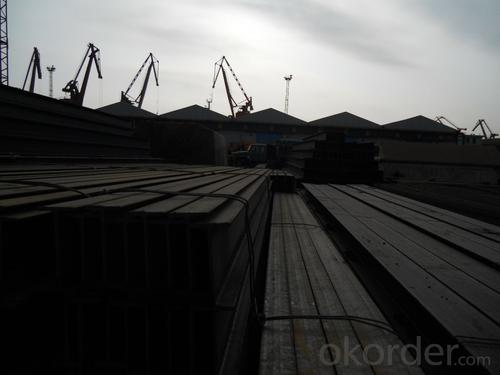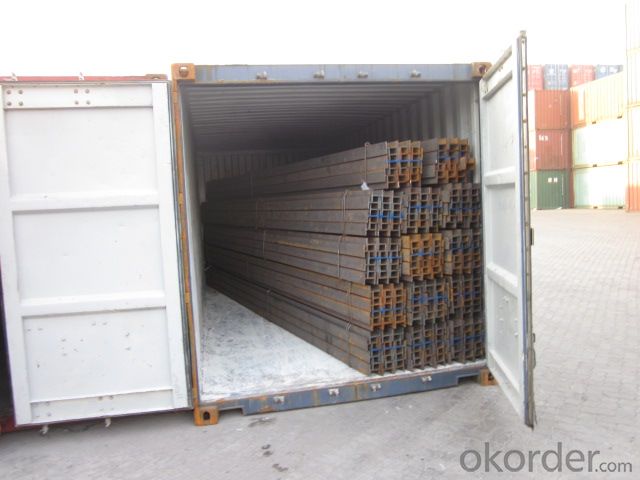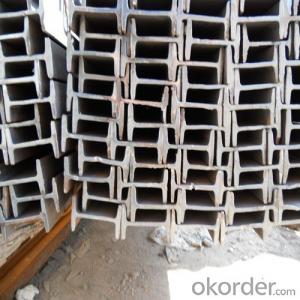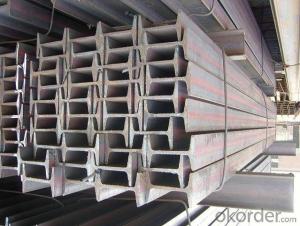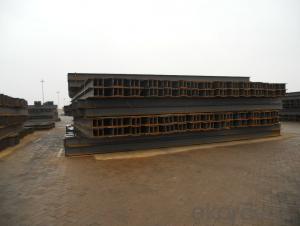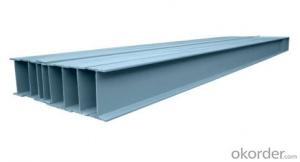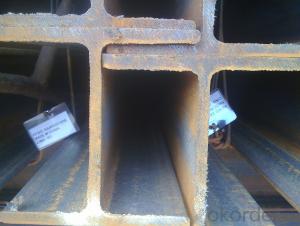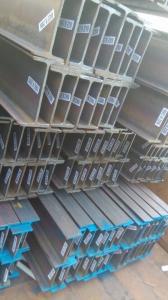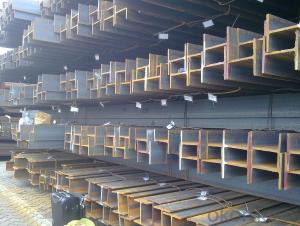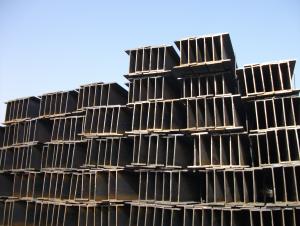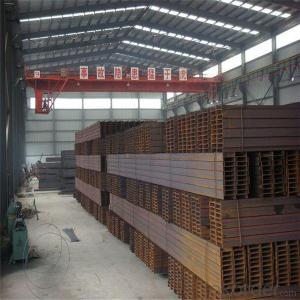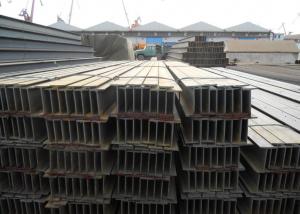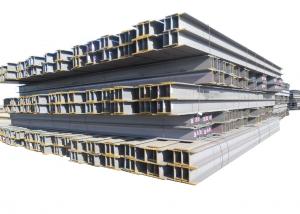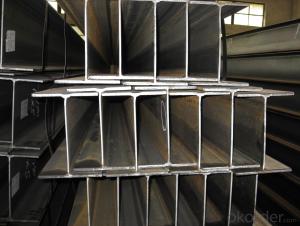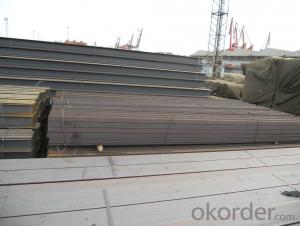Steel H-Beam for Construction with Competitive Prices
- Loading Port:
- China main port
- Payment Terms:
- TT OR LC
- Min Order Qty:
- 250 m.t.
- Supply Capability:
- 20000 m.t./month
OKorder Service Pledge
OKorder Financial Service
You Might Also Like
Specification
Product Description:
Specifications of Steel H-Beam for Construction with Competitive Prices
1. Standard: GB700-88, Q235B2.
2. Grade: Q235, SS400 or Equivalent
3. Length: 6m,10m, 12m as following table
4. Invoicing on theoretical weight or actual weight as customer request
5.Payment: TT or L/C
Usage & Applications of Steel H-Beam for Construction with Competitive Prices
Commercial building structure ;Pre-engineered buildings; Machinery support structure; Prefabricated structure; Medium scale bridges; Ship-building structure. etc.
Packaging & Delivery of Steel H-Beam for Construction with Competitive Prices
1. Packing: it is nude packed in bundles by steel wire rod
2. Bundle weight: not more than 3.5MT for bulk vessel; less than 3 MT for container load
3. Marks:
Color marking: There will be color marking on both end of the bundle for the cargo delivered by bulk vessel. That makes it easily to distinguish at the destination port.
Tag mark: there will be tag mark tied up on the bundles. The information usually including supplier logo and name, product name, made in China, shipping marks and other information request by the customer.
If loading by container the marking is not needed, but we will prepare it as customer request.
4. Transportation: the goods are delivered by truck from mill to loading port, the maximum quantity can be loaded is around 40MTs by each truck. If the order quantity cannot reach the full truck loaded, the transportation cost per ton will be little higher than full load.
5. Delivered by container or bulk vessel
Production flow of Steel H-Beam for Construction with Competitive Prices
Material prepare (billet) —heat up—rough rolling—precision rolling—cooling—packing—storage and transportation
Images
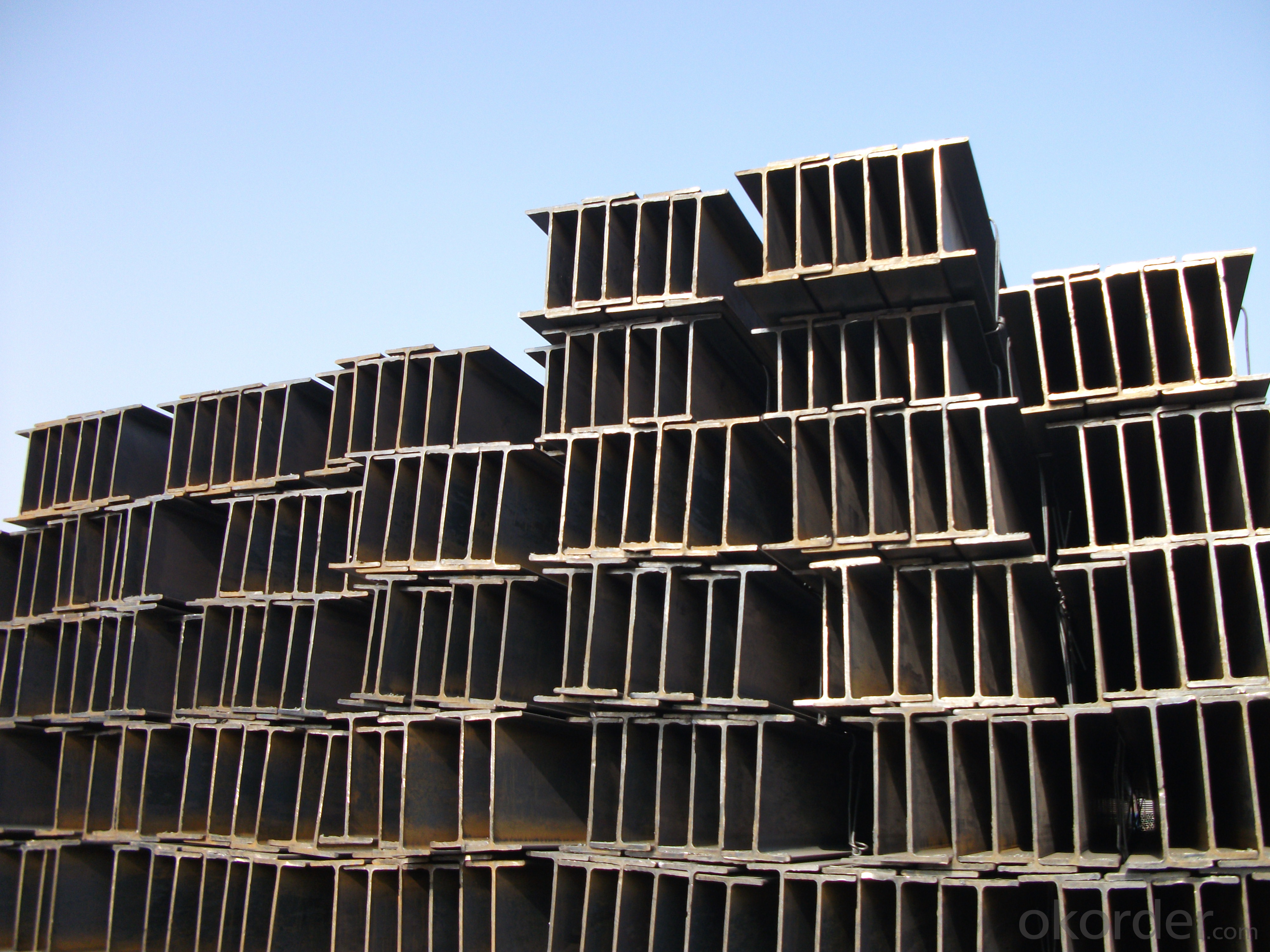
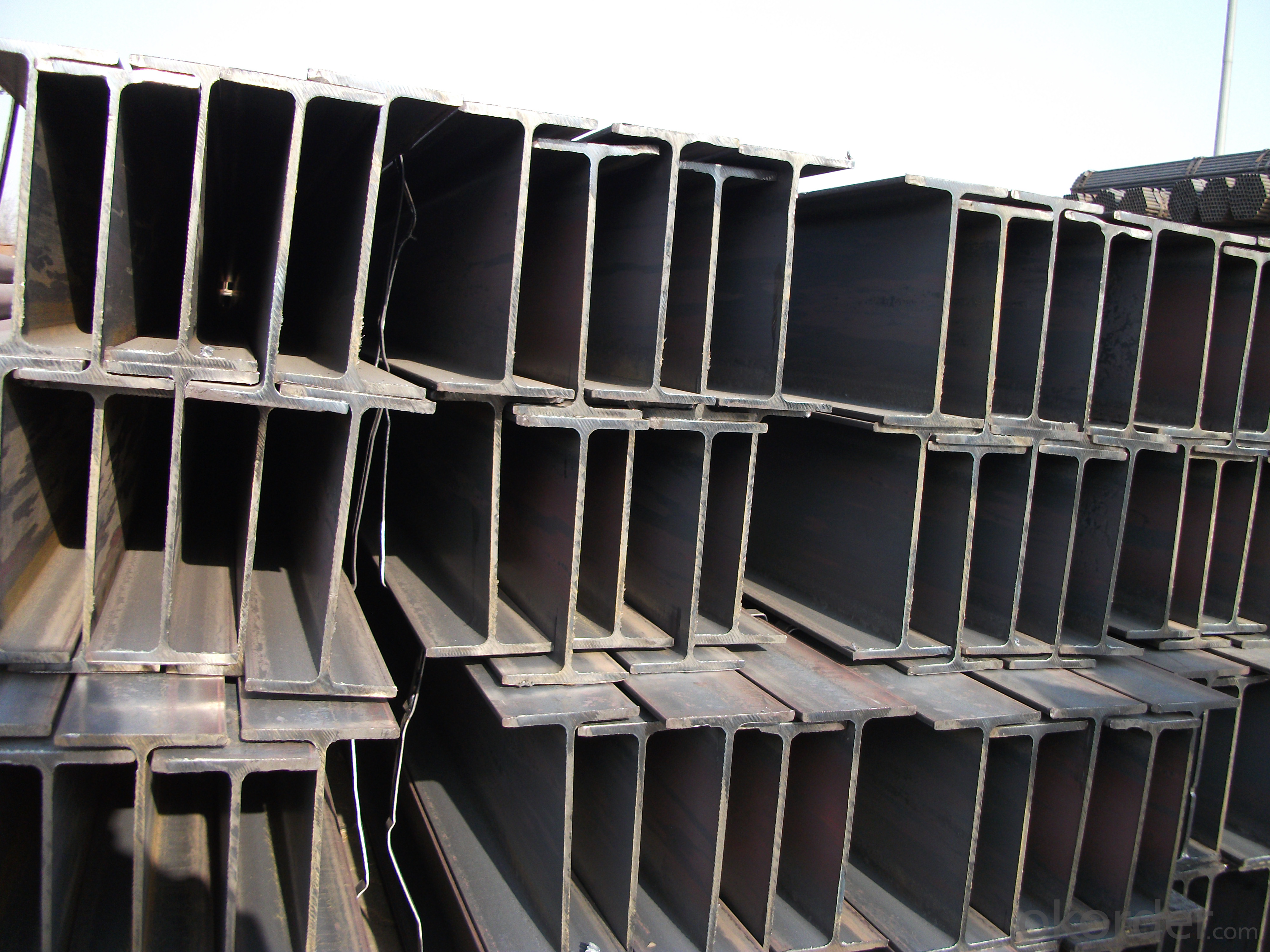
- Q: Can Steel H-Beams be used in laboratory or research facility construction?
- Indeed, laboratory or research facility construction can make use of Steel H-Beams. Owing to their robustness, longevity, and capacity to bear substantial loads, Steel H-Beams are frequently employed in the construction sector. Buildings commonly rely on them as structural components, ensuring adequate support for laboratory equipment and research facilities. Moreover, Steel H-Beams offer versatility for construction endeavors as they can be readily tailored and manufactured to meet precise design specifications.
- Q: Can steel H-beams be used in coastal or marine environments?
- Yes, steel H-beams can be used in coastal or marine environments. However, it is important to take certain precautions and use appropriate corrosion protection measures to ensure their longevity and structural integrity in these environments. Coastal or marine environments expose steel to high levels of salt, moisture, and other corrosive elements, which can accelerate the corrosion process. To mitigate the effects of corrosion, several measures can be taken. One common approach is to apply protective coatings to the steel H-beams. These coatings can be made of epoxy, zinc, or other corrosion-resistant materials. The coating acts as a barrier, preventing direct contact between the steel and the corrosive elements, thus slowing down the corrosion process. Another option is to use stainless steel H-beams, which have inherent corrosion resistance due to their high chromium content. Stainless steel is highly resistant to rust and corrosion, making it suitable for coastal or marine environments where saltwater exposure is prevalent. Furthermore, regular maintenance and inspection are crucial to ensure the continued performance of steel H-beams in coastal or marine environments. This includes routine cleaning to remove any salt deposits and monitoring for signs of corrosion or damage. Any corrosion or deterioration should be promptly addressed to prevent further structural degradation. In summary, steel H-beams can be used in coastal or marine environments with proper corrosion protection measures in place. By applying protective coatings, using stainless steel, and implementing regular maintenance and inspection protocols, steel H-beams can withstand the challenging conditions of coastal or marine environments and provide long-lasting structural support.
- Q: How to declare the processed H steel? What is the rate of tax refund? Urgent urgent
- First of all, does your company have the right to import and export?! If you have, you can use your company to declare, if not, but also to find a business right to import and export enterprises to help you act as agent.
- Q: What are the considerations when designing for acoustical isolation of Steel H-Beams?
- When designing for acoustical isolation of Steel H-Beams, there are several important considerations that need to be taken into account. Firstly, the mass of the steel beams plays a significant role in determining the level of acoustical isolation. Heavier beams tend to have better sound insulation properties due to their increased mass, which helps to absorb and block sound waves. Therefore, it is crucial to select the appropriate size and weight of H-Beams to achieve the desired level of acoustic isolation. Secondly, the structural design of the H-Beams can impact acoustical isolation. The shape and dimensions of the beams, as well as their connection details, need to be carefully designed to minimize sound transmission. Special attention should be paid to any potential flanking paths, where sound can travel through alternate routes such as wall cavities or other structural elements. These flanking paths should be identified and effectively addressed to ensure optimal acoustical isolation. Additionally, the use of appropriate insulation materials is essential for enhancing acoustical isolation. Insulation materials, such as resilient pads or rubber gaskets, can be placed between the steel beams and adjacent elements to reduce the transfer of sound vibrations. The selection and installation of these materials should be done in accordance with industry standards and guidelines to achieve maximum effectiveness. Moreover, the overall construction and assembly process should be carefully managed to avoid any compromises to acoustical isolation. Proper sealing and caulking of joints and connections between the steel beams and other building components are critical to prevent sound leakage. Attention should also be given to the installation of any penetrations through the steel beams, such as pipes or conduits, as these can create weak points for sound transmission if not properly addressed. Lastly, it is important to consider the specific requirements and regulations for acoustical isolation in the intended application or building. Different industries and building codes may have specific standards or criteria that need to be met. Consulting with acoustical engineers or specialists can provide valuable insights and guidance in ensuring compliance with the necessary acoustic isolation requirements. In conclusion, designing for acoustical isolation of Steel H-Beams involves considering factors such as mass, structural design, insulation materials, construction processes, and regulatory requirements. By carefully addressing these considerations, optimal acoustical isolation can be achieved, minimizing sound transmission and enhancing the overall acoustic performance of the building or structure.
- Q: Can steel H-beams be used in cold storage facilities?
- Yes, steel H-beams can be used in cold storage facilities. Steel is a highly durable and strong material that can withstand low temperatures without losing its structural integrity. H-beams provide excellent load-bearing capabilities, making them suitable for supporting heavy loads and maintaining the stability of the facility's structure in cold storage environments.
- Q: Are steel H-beams suitable for coastal areas with high salt content in the air?
- Steel H-beams are generally suitable for coastal areas with high salt content in the air. However, it is important to consider the specific type of steel used and take proper precautions to ensure longevity and prevent corrosion. Stainless steel or galvanized steel H-beams are highly recommended for coastal areas due to their resistance to corrosion. Saltwater carries a high concentration of salt and moisture, which can accelerate the corrosion process on traditional carbon steel. Stainless steel contains a higher amount of chromium, which forms a protective layer on the surface, preventing corrosion. Galvanized steel, on the other hand, is coated with a layer of zinc, which acts as a sacrificial barrier, protecting the underlying steel from rust. Additionally, regular maintenance and inspections are crucial to identify any signs of corrosion early on. This includes cleaning the H-beams regularly with fresh water to remove salt deposits and applying protective coatings or paints, if necessary. It is also advisable to consult with a structural engineer or a corrosion specialist to determine the specific requirements for the coastal area in question. They can provide guidance on the appropriate steel type, coatings, and maintenance procedures to ensure the longevity and structural integrity of the H-beams in coastal environments.
- Q: How do steel H-beams perform in oil and gas industry applications?
- Steel H-beams are widely used in the oil and gas industry due to their exceptional performance characteristics. These beams have proven to be highly reliable and effective in various applications within the industry. One of the primary advantages of steel H-beams is their strength and durability. They are designed to withstand heavy loads and provide structural support, making them ideal for use in oil and gas platforms, pipelines, and storage tanks. Steel H-beams have high tensile strength, which allows them to resist bending and deformation under extreme conditions. In addition to their strength, steel H-beams also offer excellent corrosion resistance. The oil and gas industry operates in harsh environments that expose equipment and structures to corrosive elements like water, salt, and chemicals. Steel H-beams are often coated with protective layers or made from corrosion-resistant alloys to ensure long-term performance and prevent deterioration. Another important characteristic of steel H-beams is their versatility. They can be easily fabricated and tailored to specific project requirements, such as length, width, and load-bearing capacity. This flexibility makes them suitable for a wide range of oil and gas applications, from offshore platforms to onshore processing plants. Furthermore, steel H-beams are known for their cost-effectiveness. They offer a high strength-to-weight ratio, meaning they can support heavy loads while minimizing material usage. This not only reduces construction costs but also allows for more efficient transportation and installation. Overall, steel H-beams have proven to be highly reliable and efficient in oil and gas industry applications. Their strength, corrosion resistance, versatility, and cost-effectiveness make them a preferred choice for various structural and support systems, contributing to the overall safety and efficiency of operations in the industry.
- Q: Can steel H-beams be used for residential construction?
- Yes, steel H-beams can be used for residential construction. They are commonly used in the construction of residential buildings and provide structural strength and stability. Steel H-beams offer several advantages such as durability, versatility, and the ability to support heavy loads, making them suitable for various residential construction applications.
- Q: Are steel H-beams suitable for structures with complex geometries?
- No, steel H-beams are not suitable for structures with complex geometries. They are primarily used in simple, linear structures where their strength and load-bearing capacity can be optimized. Complex geometries often require more flexible and customizable structural solutions.
- Q: Can steel H-beams be used in shopping mall construction?
- Yes, steel H-beams can be used in shopping mall construction. Steel H-beams are commonly used in construction due to their strength and load-bearing capabilities. They provide structural support and are often used for beams, columns, and trusses in commercial buildings like shopping malls.
Send your message to us
Steel H-Beam for Construction with Competitive Prices
- Loading Port:
- China main port
- Payment Terms:
- TT OR LC
- Min Order Qty:
- 250 m.t.
- Supply Capability:
- 20000 m.t./month
OKorder Service Pledge
OKorder Financial Service
Similar products
Hot products
Hot Searches
Related keywords



